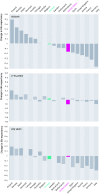Recent trends in life expectancy across high income countries: retrospective observational study
- PMID: 30111634
- PMCID: PMC6092679
- DOI: 10.1136/bmj.k2562
Recent trends in life expectancy across high income countries: retrospective observational study
Erratum in
-
Recent trends in life expectancy across high income countries: retrospective observational study.BMJ. 2018 Aug 22;362:k3622. doi: 10.1136/bmj.k3622. BMJ. 2018. PMID: 30135175 Free PMC article. No abstract available.
Abstract
Objectives: To assess whether declines in life expectancy occurred across high income countries during 2014-16, to identify the causes of death contributing to these declines, and to examine the extent to which these declines were driven by shared or differing factors across countries.
Design: Demographic analysis using aggregated data.
Setting: Vital statistics systems of 18 member countries of the Organisation for Economic Co-operation and Development.
Participants: 18 countries with high quality all cause and cause specific mortality data available in 2014-16.
Main outcome measures: Life expectancy at birth, 0-65 years, and 65 or more years and cause of death contributions to changes in life expectancy at birth.
Results: The majority of high income countries in the study experienced declines in life expectancy during 2014-15; of the 18 countries, 12 experienced declines in life expectancy among women and 11 experienced declines in life expectancy among men. The average decline was 0.21 years for women and 0.18 years for men. In most countries experiencing declines in life expectancy, these declines were predominantly driven by trends in older age (≥65 years) mortality and in deaths related to respiratory disease, cardiovascular disease, nervous system disease, and mental disorders. In the United States, declines in life expectancy were more concentrated at younger ages (0-65 years), and drug overdose and other external causes of death played important roles in driving these declines.
Conclusions: Most of the countries that experienced declines in life expectancy during 2014-15 experienced robust gains in life expectancy during 2015-16 that more than compensated for the declines. However, the United Kingdom and the United States appear to be experiencing stagnating or continued declines in life expectancy, raising questions about future trends in these countries.
Published by the BMJ Publishing Group Limited. For permission to use (where not already granted under a licence) please go to http://group.bmj.com/group/rights-licensing/permissions.
Conflict of interest statement
Competing interests: All authors have completed the ICMJE uniform disclosure form at www.icmje.org/coi_disclosure.pdf and declare: JH and AH had financial support from the Robert Wood Johnson Foundation, JH had financial support from the National Institute of Child Health and Human Development, and AH had financial support from the National Institute on Aging for the submitted work; no financial relationships with any organizations that might have an interest in the submitted work in the previous three years; no other relationships or activities that could appear to have influenced the submitted work.
Figures





Comment in
-
Reversals in life expectancy in high income countries?BMJ. 2018 Aug 15;362:k3399. doi: 10.1136/bmj.k3399. BMJ. 2018. PMID: 30111573 No abstract available.
References
-
- Bongaarts J. How long will we live? Popul Dev Rev 2006;32:605-28 10.1111/j.1728-4457.2006.00144.x. - DOI
-
- Kochanek KD, Murphy SL, Xu JQ, Arias E. Mortality in the United States, 2016. NCHS Data Brief, no 293. National Center for Health Statistics, 2017. - PubMed
-
- Xu JQ, Murphy SL, Kochanek KD, Arias E. Mortality in the United States, 2015. NCHS data brief, no 267. National Center for Health Statistics, 2016. - PubMed
-
- Crimmins EM, Preston SH, Cohen B, eds. National Research Council Panel on Understanding Divergent Trends in Longevity in High-Income Countries. International Differences in Life Expectancy at Older Ages: Dimensions and Sources. National Academies Press, 2010. - PubMed
Publication types
MeSH terms
Grants and funding
LinkOut - more resources
Full Text Sources
Other Literature Sources
